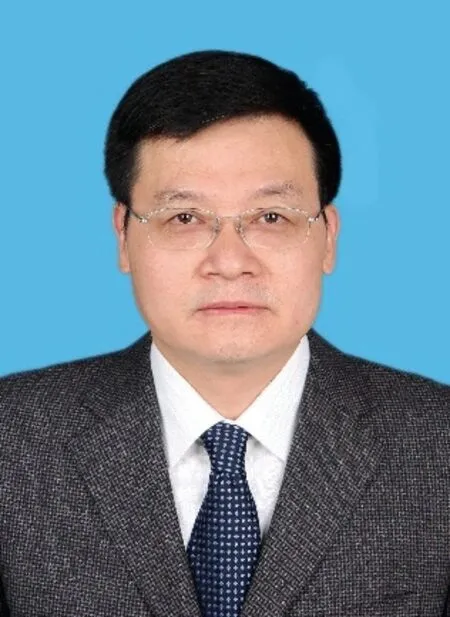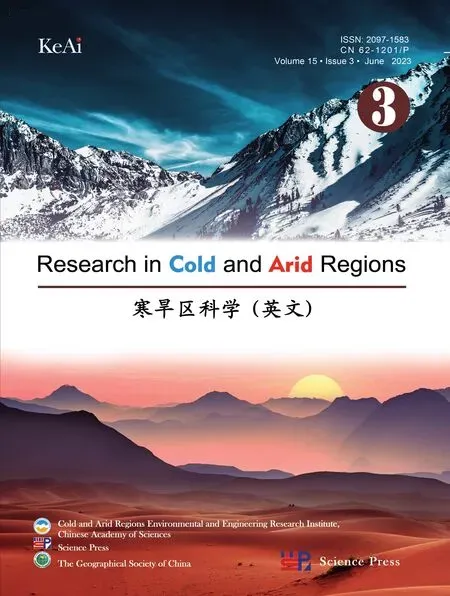Editor-in-Chief Yuanming Lai

Yuanming Lai (China)
Editor-in-Chief Yuanming Lai,Academician of Chinese Academy of Sciences,director of Northwest Institute of Eco-Environment and Resources,Chinese Academy of Sciences,Lanzhou,China,Associate Editor ofCold Regions Science and Technology.
Frozen ground accounts for 50% of the earth's land area.With rapid economic development,more and more infrastructures are being constructed in the broad cold regions,resulting in disturbance to the heat balance of the cold environment.Meanwhile,climate warming impacts have been observed worldwide,with more severe effects occurring in the cold regions.Under the combined actions of climate warming and infrastructure development,the frozen ground has degraded and will continue to deteriorate.Due to substantial concerns on the ensuing damages,mitigation for frost heave and thaw settlement of foundations in cold regions has become a vital issue.
Prof.Yuanming Lai has conducted extensive and systematic theoretical research on frozen soilrelated engineering problems in cold regions.His outstanding work includes strength criteria for and constitutive relationships of frozen soils,prediction methods of frost hazards,and key preventive and mitigation technologies for its impact on the built infrastructures.These contributions are highly regarded and recognized as significant innovations in advancing the computational theories for cold regions engineering.Prof.Lai's major scientific achievements are summarized as follows.
a) Configurations and computational theories of Highly Effective Active Cooling Roadbeds
Prof.Lai systematically studied the laws governing the temperature changes,cooling effect,and mechanisms of crushed-rock layers with periodical boundary temperatures and proposed an optimal range of stone diameters of crushed-rock embankments (i.e.,10 to 30 cm) for effective cooling.This timely research completed before 2002 provided a critical scientific basis for the design and construction of the Qinghai-Tibet Railway.
Prof.Lai developed theories of non-Darcy fluids and heat transfer for crushed-rock layers of large particle sizes.He established a novel mathematic model with open boundary conditions and corresponding computation methods for analyzing the characteristics of temperature and flow fields,heat convection,and cooling effects of crushed-rock embankments in permafrost regions.These contributions helped solve the fundamental scientific problems of fluid-solid coupled heat transfer of crushed-rock embankments for the Qinghai-Tibet Railway.
He proposed an innovative,U-shaped crushed-rock embankment structure to ensure the thermal stability of permafrost roadbeds under a projected climate warming of 2.6 degrees centigrade over the next 50 years on the Qinghai-Tibet Plateau.Such a roadbed configuration can mostly offset the impacts of climate warming on the Qinghai-Tibet Railway.This research provided crucial technological support for the design of railway embankments on warm permafrost.
Prof.Lai formulated a finite-element method accounting for heat convection in porous earth materials for analyzing the temperature distribution features of embankments with sunny and shaded slopes in permafrost regions.Concurrently,he proposed a novel asymmetric crushed-rock revetment with a 160-cm-thick crushed-rock layer on the sunny slope and 80-cm thick one on the shaded slope.This original configuration effectively resolves issues such as embankment uneven thaw settlements and longitudinal roadbed cracks resulted from uneven ground temperature distribution.
The dark surface of asphalt pavement of large-width (such as high-grade highways or expressways) is very effective in absorbing and accumulating heat in the subgrade,which can rapidly destabilize the underlying permafrost foundations.To address this issue,Prof.Lai proposed two types of composite embankments,i.e.,one with L-shaped thermosyphons and crushed-rock revetments,and the other with a duct-ventilated crushed rock layer.He further developed a numerical model for analyzing the fluid-solid coupled heat transfer for the latter.Both field testing and model simulation results demonstrate that both composite embankment structures have greatly enhanced cooling effect due to significantly altered heat exchange modes.These two composite embankment configurations provide excellent candidates for the design of high-grade highway foundations,which require long-term thermal stability under a projected climate warming of 2.6 degrees centigrade over the next 50 years.
b) Computational theory for tunnels in cold regions
Prof.Lai is also a pioneer in mathematical-mechanical modeling of the complex fields consisting of temperature,seepage,and stress coupled with phase changes.He developed a numerical method for assessing the stress and temperature fields inside the tunnel liners and surrounding soil strata under the joint action of the volumetric force of seepage,and creep and frost heave of frozen soils.His model helped elucidate and solve vital scientific problems of frost damage to the tunnels in cold regions.Also,Prof.Lai proposed an elastic viscoplastic method for the analysis of the seismic response of tunnels in cold regions.All these contributions provided a solid theoretical basis for the proper design of tunnels in cold regions.It is worth noting that Prof.Lai proposed a suite of techniques for mitigating the frost-related hazards resulting from the cooling of surrounding rocks exposed to the cold air,whose effectiveness has been confirmed by field data.
c) Physics,Strength criteria and constitutive models for frozen soils
Prof.Lai analyzed the cryogenic process of saturated soils through experiments.He established a hydro-thermal-mechanical interacting model to reveal the formation of a discrete ice lens.This model can well capture the ice segregation near the frozen fringe.His hydro-thermal-saltmechanical coupled model helps describe the influence of salt crystalization on the cryostructure of saline soils.These contributions provided a theoretical basis for the prediction of frost heave and salt expansion.
Prof.Lai established a three-dimensional damage surface for a generalized stress state and a strength criteria for frozen silts upon pressure melting through extensive experiments.He also proposed a general elastoplastic constitutive model with multiple yield surfaces and non-associated flow rules.This model can describe the complex deformation of frozen silts under various stress levels,such as strain softening and hardening,shear dilation,and volumetric contraction.
Prof.Lai presented an analytical method to determine the pressure-crushing and melting of the ice in frozen soil.He formulated a new systematical approach for deriving yield criteria and flow rules from dissipation function based on the properties of a homogenous function.His notable accomplishments on frozen loess include the establishment of a Gibbs free-energy function and dissipation function,and an elastoplastic incremental constitutive model from the two thermodynamic functions.
Prof.Lai found that salt content and confining pressure have significant effects on the strength and deformation properties of frozen sulfate saline soils under cyclic loading and proposed a bounding surface elastoplastic constitutive model based on test results.He introduced a critical stress ratio and bounding surface shape parameter into the plastic potential surface and bounding surface functions to describe pressure melting and crushing characteristics of frozen soils.Furthermore,he studied the influence of the initial anisotropy and the induced anisotropy by dynamic loads on the bounding surface with rotation hardening.
Based on the irreversible process of thermodynamics,Prof.Lai formulated a thermoporomechanics-based poro-elasto-viscoplastic damage constitutive model for saturated frozen soils using the Lagrangian saturation and solid-fluid interface interaction.His work helps elucidate the overall plastic stress-strain relationship by scaling up the microscopic properties of saturated frozen soil considering the combined influences of micro-plasticity and interface interaction.This study provides a theoretical basis for analyzing the stress-induced deformation considering the effects of creep and strain rate on saturated frozen soils.
Prof.Lai conducted numerous experiments to study the uncertainty and randomness of mechanical characteristics of frozen soils near their freezing/thawing points.Through these studies,he determined the strength distribution and established a stochastic damage constitutive model for describing the stress-strain relationship of warm frozen soils.
For his marvelous accomplishments on the theories and applications of cold regions engineering,Prof.Yuanming Lai has earned numerous honors and national awards,including the State Technological Invention Award (2ndClass,2010),the State Science and Technology Progress Award of China (Grand Prize,2008),the Innovation Team Award of the State National Science and Technology Progress Awards of China (equivalent to 1stClass,2017) and the State Science and Technology Progress Awards (2ndClass,2005),all from the Chinese State Council.Prof.Lai has authored or co-authored 356 papers,including 181 articles indexed by SCI,in peer-reviewed journals,such asInternational Journal of EngineeringScience,International Journal of Plasticity,International Journal of Mechanical Sciences,International Journal of Heat and Mass Transfer,ASCEJournal of Cold Regions Engineering,Cold Regions Science and Technology,etc..He has published four academic monographs and has eleven patents.Prof.Yuanming Lai is truly a worldrenowned scientist in cold regions engineering.
 Sciences in Cold and Arid Regions2023年3期
Sciences in Cold and Arid Regions2023年3期
- Sciences in Cold and Arid Regions的其它文章
- Impacts of canopy structure on the sub-canopy solar radiation under a deciduous forest based on fisheye photographs
- Influence of climate change on hydrological process in the upper reaches of Shiyang River: A case study of the Xiying River,China
- Seepage influence of supra-permafrost groundwater on thermal field of embankment on Qinghai-Tibet Plateau,China
- An overview of the policies and models of integrated development for solar and wind power generation in China
- Progress on research and mitigation of wind-blown sand risk in Dunhuang Singing Sand Mountain and Crescent Spring Scenic area,China
- Guidelines to Authors
